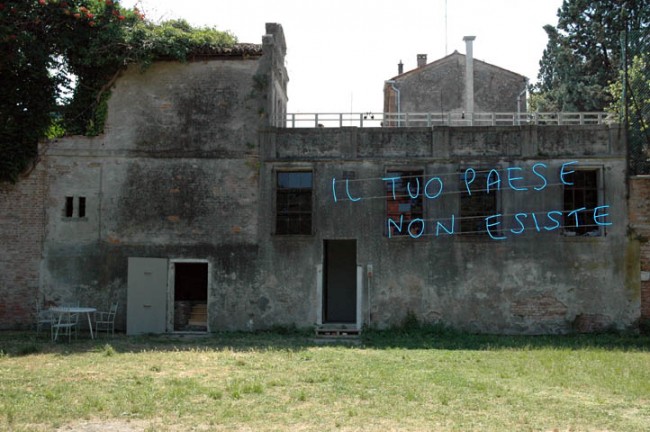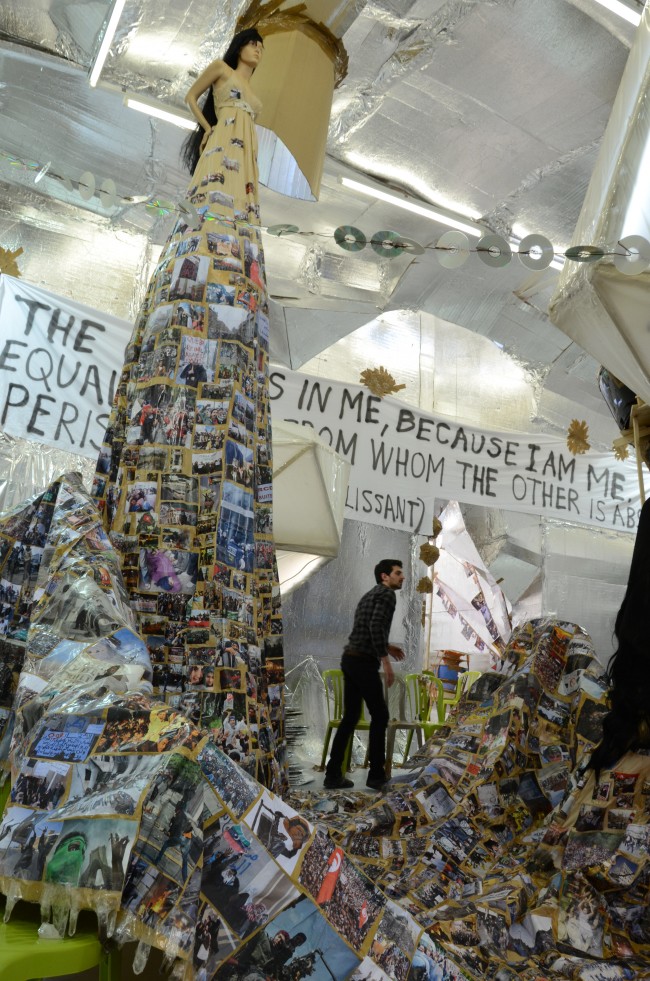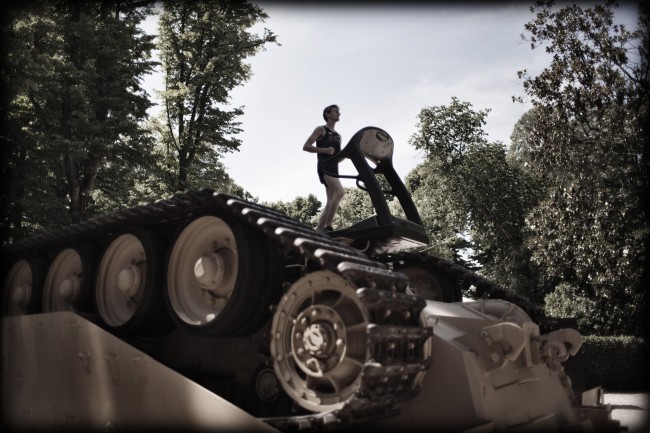Visiting the National Pavilions

After my initial perusal of the Arsenale, the opening of the Venice Biennale continued at a frenetic pace, alternating between tight lanes and elegant palazzos, prosecco and espresso.
Rancière on Slippages in Time

Providing a much needed break from the constant stream of openings, Norway presented a lecture series entitled The State of Things. The series kicked off with a talk by Jacques Rancière, who delivered a rapid-fire meditation on the relationship of time to systems of power.
Looking at the role of the state in controlling a sense of time, Rancière referenced Husni Mubarak’s offer to change the results of the last election to appease protesters during the recent uprising — an offer that asserts the state’s potential to go back in time and change events. However, it was the “interruption” that the protests caused which would ultimately construct another time, one formed collectively by the demonstrators in Tahrir Square, and that would spread and eventually run out the clock on regime. These “interruptions,” described by Rancière as a breakdown in the social machine that structures the time of domination, can also occur in everyday life – for example, when public transportation is disrupted. Hopefully the knowledge that you are participating in an emancipatory moment the next time you are waiting in the cold for a late bus should provide some solace.
But it is not simply a matter of one time supplanting another. Rather, in a Foucauldian turn, Rancière calls for the framing of a “heterochrony,” a space for a multiplicity of times to co-exist, and the potential to work through the tensions where different times meet and overlap.
When asked to comment on the moment of the biennale, Rancière dithered, equating the regularity of the event to elections, and running through the standard list of criticisms of mega-exhibitions and the art world’s cozy relationship with power and the market. Searching for something positive to conclude with, he noted that like any institution, the biennale can provide a crossroads for the practices to meet, “so it’s not always the worst that happens.” By that standard, it seems the ever increasing crowds could be considered a testament to the Biennale’s endurance.
Echoes of the Past, and Dark Realities of the Present

The other half of Bice Curiger’s Biennale exhibition puts forth its own clash of time. The show inhabits what is now called the Central Pavilion, its second name change in consecutive editions (from the long-standing misnomer, “Italian Pavilion,” to the short-lived “Palazzo delle Esposizioni”). Occupying the main room of the pavilion is a trinity of Tintoretto paintings. Transferred from the Church of San Giorgio Maggiore and the Academia in Venice, they anchor the center of the exhibition deep in time.
This rupture in the present is intended to recall the importance of light (an overarching theme of the Biennale), and the period of intensive experimentation in the art of the 16th century that upended the rigid geometries of the early Renaissance. The curatorial strategy of including these historical pieces is not particularly new; however, the gesture is effective at creating a temporal rupture — one that evokes Rancière’s heterochronic time.
Just as disturbing as this wrinkle in time was the phalanx of armed guards with black military boots that patrolled the room, stationed for security at the request of the lending institutions. With pistols exposed on their hip, and visibly nervous given the size of the crowds, the introduction of these instruments of violence into the exhibition posed inadvertently further questions; particularly the relationship of art when confronted with the potential of conflict, and a broader notion that can loosely be termed politics.
Curiger attempted to address the latter relationship in a questionnaire to artists included in the show. Stemming from the title of the exhibition, the query “Is the art community a nation?” seemed a bit frightening. Thankfully, Swiss artist duo Fischli and Weiss promptly responded with their own interrogatory: “Are flowers people?”
Art and Engagement
There were a small number of exhibiting artists whose work addressed the notion of engagement and community. One of the few works that was produced for the Biennale was also one that worked with the locality, and happened to be the most invisible. Marinella Senatore composed the Eastman Radio Drama from interviews taken across the lagoon in the industrial port of Marghera, famed for its labor struggle in 60s and 70s. The end result is a choreography of voices and narratives that is able to slip into the vehicle of a radio play and be broadcast on stations all over Italy.

Meanwhile, the transposition of communities is explored in Five Thousand Feet is the Best by Omer Fast, which presents a staged interview with an elusive drone pilot and the story of a drone strike set in the American west. In a role reversal of sorts, a suburban family leaves their occupied town and is trying to escape the conflict, when they come across three men near a pickup truck planting a bomb in the road. A drone watches above awaiting permission to fire, and the family ends up as collateral damage to the strike. While many aspects of the film (such as the consistent reflexivity and the blurring of boundaries of fiction through re-presentation) are present in other works of Fast’s growing videoteca, the introduction of the role reversal — a device that becomes more mature in his Nostalgia — effectively displaces the subjects and the viewer, creating the conditions for positions to shift, and the potential to escape fixed geographical or cultural notion of identity. While at certain points the visual quality of the film makes it appear as if Fast is auditioning to direct Oceans 14, its unwavering criticality more than balances out the Hollywood style.
The Swiss Pavilion hosts Thomas Hirschhorn, whose all-encompassing installation Crystal of Resistance is like wandering through the encrusted belly of hyper-capitalist excess, haphazardly packing-taped to media images and then cooked in the microwave of ideology. Hirschhorn’s usual collection of mannequins, photos of corpses deformed by war, exercise machines, beer cans and magazines collide to form spaces of exclusion and suspension. No matter how prepared one is to see his images depicting individuals mutilated and deformed—images which are excluded from the use in the anesthetized daily news due to their ‘graphic’ content—they continually manage to affront the senses and force an examination of our safe or contrived notions of the face of violence. His work, however, is not polemical — or at least is not predominately so; rather, there is the continual feeling shuttling between a euphoric resistance and an ecstatic state of construction.
The Pavilion as Memorial

Another totalizing pavilion came in the form of a memorial to the provocative filmmaker, theater director and artist Christoph Schlingensief, who died last year from a long bout with lung cancer, only a few months after being chosen to represent Germany at the Biennale. Left with only preliminary sketches of his project, curator Susanne Gaensheimer (in collaboration with the artist’s widow and others) chose to re-stage his large scale autobiographical theatrical installation, A Church of Fear vs. the Alien Within (Eine Kirche der Angst vor dem Fremden in mir) (2008), which incorporates early film and still footage overlaid with audio of the artist describing his struggle with his impending mortality. Arranged as a sort of spiritual wunderkammer in a replica of a church Schlingensief frequented in his youth, the pavilion also contains a cinema which regularly screens his feature length films, and documentation of the development of his ‘opera village’ in Burkino Faso, in a town outside of Ouagadougou which will contain a theater, drama school, and hospital.
Across the garden was another posthumous memorial — here, a work dedicated to the new media artist Ahmed Basiouny, who was killed on the third day of protests in Tahrir Square, occupies the Egyptian Pavilion. The pavilion houses projections of scenes from the artist’s performance 30 Days of Running in the Place, done a year earlier in Cairo. In it he donned a biohazard-type suit and stepped inside a quarantined environment in public, where he commenced to run for an hour. The suffocating and exhausting results were made visible through sensors that would pick up his body temperature. The documentation of the performance is randomly interwoven across five screens, alongside raw footage of the protests taken by the artist the day before his death. The artist’s actual intended use of the scenes from Tahrir Square is unknown, which draws into question the authorship of installation. There is, however, a pervasive sense of urgency about the pavilion that stands out in contrast to the rest of the nations in the giardini.
Power, Statehood and Sovereignty
Dominating the end of one of the principal lanes, and befitting its imperial status at the time of its construction, the British Pavilion transports one across the Bosporus into an architectural maze that conflates a sense of place and its location in time. Mike Nelson’s built environment, based on his stay in Istanbul, weaves entire rooms and facades into an unfolding narrative of experience, akin to a byzantine Alice in Wonderland. The redux of the installation, which was first conceived for the 8th Istanbul Biennial, alludes to the deep historical relationship between Constantinople and Venice, evidence of which is manifested in every ogee window of a palazzo.

A din periodically emanates from the rumbling treads of the overturned M1 Abrams tank, beached in front of the American Pavilion, and topped with a treadmill where a lone runner from USA Track & Field plods along under the unrelenting Venetian sun. This militaristic mirage by Jennifer Allora and Guillermo Calzadilla is the introduction to Gloria, the Puerto-Rican based duo’s slightly sardonic take on the emblems of state power, capital and physical exhaustion. Inside, two sets of wooden business class airline seats provide a platform for alternating performances. The male gymnast in American Airlines—taking its title from the seats’ namesake—is clad in an official, red, full-body suit which one could mistake as Soviet. He begins a regiment of handstands, balancing gestures and pivots around the wooden armature; the routine is punctuated by pauses, where the act of breathing and fatigue becomes more evident as the laborious exercise increases into more ostentatious displays of strength and agility, complete with running leaps and twists on and over the sculptural elements. A choreography of entropy—and here we can choose read to the Olympian not only as a body participating for a nation, but rather the embodied representation of the state itself.
The Israeli/Dutch artist Yael Bartana is the first non-Polish artist to represent Poland in the Biennale. Her suite of videos — including Mur i wieża (Wall and Tower), Mary Koszmary (Nightmares), and Zamach (Assassination) — is based on a fictitious group, the Jewish Renaissance Movement in Poland, that advocates for a return of the over three million Jews which disappeared during the turmoil of the twentieth century. Central to the films is the charismatic young activist who, in the first piece, delivers an impassioned speech to a mostly vacant stadium. By the last film, a public plaza is filled to commemorate his assassination and listen the testimony of a Holocaust survivor. The artist’s desire to have the ‘movement’ transcend the screen by, in part, working with non-actors and organizing a series of talks and workshops at the next Berlin Biennale allows Bartana’s imaginary politics to spill over into the realm of possibility.

Outside of the gardens in an old woodworking shop, the first Iraq Pavilion in 35 years looks at practices from two generations of the diaspora. Walid Siti examines the relationship between the high octane post-conflict economy in the north and its fragile symbols in the natural surroundings. Beauty Spot displays moving images of the Geli Eli Beg waterfall surrounded by a grandiose 5000 Iraqi dinar note, on which the cascade is represented. Recently, a drought in the region dried up the tourist attraction, and in a somewhat questionable use of funds, the regional government hired a Lebanese company to divert massive amounts of water resources to restore the national symbol. From the younger generation of artists who grew up during the Iran-Iraq conflict, Helsinki-based Adel Abidin playfully explicates the zero-sum game of war in his video of dueling office workers, where two business suit-clad employees battle with the florescent tubes, à la Star Wars, until all of the bulbs in the room are spent.

Iraq also had a presence at the Icelandic Pavilion. The recent invasion in 2003 was the impetus for the ongoing project Your Country Doesn’t Exist by the duo Libia Castro and Ólafur Ólafsson. This incarnation of the project employed musicians and an opera singer to bring their Brechtian libretto through the canals of Venice on a gondola. In another work from the series, they invite the Icelandic Ambassador to complete a paint-by-number canvas spelling out the title of the project. The state functionary can’t bring himself to negate with a brush the notion of sovereignty, and instead paints “Your Country Does Exist.”
Leaving the Biennale
At the end of the long week of festivities, the art mob had disappeared almost overnight. On a bright clear morning the day after the official opening, the mega-yachts were gone and in their wake the regatta in honor of Ascension Day silently rowed down the grand canal. A myriad of brightly colored skiffs with standing oarsmen surrounded the Bucintoro, the gilded barge of the Doge, which hoisted the oversized crimson red banner of St. Mark. As the procession in the lagoon drifted passed, it seemed to glide over the rupture in time — an ephemeral representation of a once grand power that recalls a certain continuity with a past. And despite the outdated vehicle, the spectacle of the Bucintoro, like the Biennale, still manages to stay afloat against the currents of time.








[…] Siti, Beauty-spot, installation, 2011 (http://fnewsmagazine.com/2011/07/biennale-binge-part-2/ […]
[…] Siti, Beauty-spot, installation, 2011 (http://fnewsmagazine.com/2011/07/biennale-binge-part-2/ […]